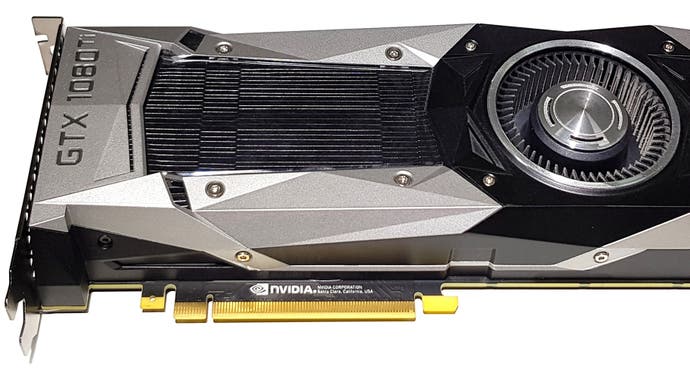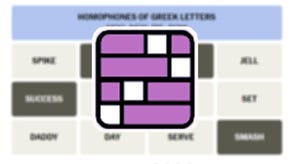Nvidia GeForce GTX 1080 Ti benchmarks: 4K/60 is within reach
With RTX 2080 levels of performance in some games and a price drop, the 1080 Ti might become the better value card.
The GeForce GTX 1080 Ti was perhaps the first graphics card that could actually handle 4K gaming without accepting chronically slow frame-rates or greatly diminished graphical settings. The card was about 25 to 30 per cent faster than its nearest rival, the GTX 1080, and is only matched on the Red Team's side by the recently released Radeon 7. With a strong demand for used GTX 1080 Ti cards, this groundbreaking card may yet remain a viable choice in the RTX era if you can find one at a fair price.
With such a degree of power at your fingertips, there's little that you can't do with the GTX 1080 Ti. 4K gaming at 60 frames per second is a given for most titles, but this graphics card is also able to drive VR headsets such as the HTC Vive Pro, high resolution ultra-wide monitors and even high refresh rate displays up to 240Hz (though in that scenario, ensure you pair your GTX 1080 Ti with a fast Intel Core i7 or Core i9 processor). All things considered, it sits only behind the RTX 2080 and RTX 2080 Ti on our ranking of the fastest graphics cards on the market.
In order to give you a good idea of what to expect from the GTX 1080 Ti, we'll be testing its performance in a range of titles released within the last few years, as well as a few older titles. In each case, you should expect similar levels of performance when using the same very high or ultra settings with a suitably high-end processor and other components.
Which GPUs are worth buying? We've made our picks for the best graphics cards available, updated with the latest graphics cards as they're released. As well as an overall performance champ, we name the best value graphics card and best cheap graphics card to guide your next upgrade.
For this benchmark roundup, we'll compare the GTX 1080 Ti against its little brother, the GTX 1080, plus two new Turing cards, the RTX 2080 and 2070. We'll also throw in AMD's new Radeon 7 GPU to give you an idea of how Team Red stacks up against Team Green. It's worth noting that the RTX 2080 and 2070 cards we tested are factory overclocked Founders Edition models, while the GTX 10-series cards came at reference clocks.

| RTX 2080 | RTX 2070 | GTX 1080 Ti | GTX 1080 | Radeon 7 | |
|---|---|---|---|---|---|
| GPU cores | 2944 | 2304 | 3584 | 2560 | 3840 |
| Giga Rays/sec | 8 | 6 | 1.21 | 1? | ? |
| RTX-OPS | 60T | 45T | 12T | 8T | ? |
| VRAM | 8GB GDDR6 | 8GB GDDR6 | 11GB GDDR5X | 8GB GDDR5X | 16GB HBM2 |
| Memory Bus | 256-bit | 256-bit | 352-bit | 256-bit | 4096-bit |
| Mem. Bandwidth | 448GB/s | 448GB/s | 484GB/s | 352GB/s | 1024GB/s |
| Base Clock | 1515MHz | 1410MHz | 1480MHz | 1607MHz | 1400MHz |
| Boost Clock | 1710MHz | 1620MHz | 1582MHz | 1733MHz | 1800MHz |
| TDP | 215W | 175W | 250W | 180W | 300W |
For each game, you'll see our new bespoke Digital Foundry benchmarking system if you're viewing the desktop version of this page. A YouTube video will show you the scene that we tested each card on, with live frame-rate and frame time data embedded below.
This system is more customisable than "baking in" this information onto the video itself, as you can use the controls to the right of the video to add or remove different cards and resolutions according to your needs. For example, you could look at how one card handles both the 1440p and 4K runs, or see four different cards tackle the 4K benchmark simultaneously.
Below the real-time telemetry, you can find summarised results for the entire run, including the incredibly useful lowest one per cent and lowest five per cent figures, which give you an idea of minimum frame-rates offered by each GPU. To see these different stats, mouse over the image and watch as the readings change accordingly. You can also click the barchart to change the absolute figures into percentages, and click again to change them back to absolute values.
Now that we've covered the benchmarking tool, let's get right into the results.
Assassin's Creed Odyssey
The GTX 1080 Ti acquits itself well in the first benchmark we're looking at, Ubisoft's Assassins Creed Odyssey. The large and detailed open world of this game makes it challenging to render, and we can see that with the 1440p results here: only the GTX 1080 Ti and RTX 2080 manage to sustain 60fps or higher on average. The RTX 2070 is nine per cent behind the GTX 1080 Ti here, while the RTX 2080 is three per cent ahead of the flagship Pascal card. At 4K, we see the GTX 1080 Ti again take second place with a playable 31fps, although we'd definitely recommend the use of G-Sync to smooth out any scene-to-scene frame time variation.
AC Odyssey: Ultra High, TAA
Assassin's Creed Unity
We move onto a classic title that still threatens modern cards, 2014's Assassin's Creed Unity. The 1080 Ti remains close to the RTX 2080 here at 1440p and 4K, with just a few frames per second separating the two cards. This shows that a (used) 1080 Ti could be a better value purchase if you can find one at a lower price than the next-generation hardware - at least in some titles. The Radeon 7 still struggles with the depth of field effect here, hamstringing its performance.
AC Unity: Ultra High, FXAA
Battlefield 1
2016 title Battlefield 1 is our next test. As the game lacks a dedicated benchmark, we've jury-rigged a repeatable section from the game's short but sweet campaign mode. In contrast to our previous test, the RTX 2080 pulls ahead of the GTX 1080 Ti here, with about a four per cent margin at 1440p and closer to six per cent at 4K. The Radeon 7 shows its best performance here, pulling way ahead of the RTX 2080 at both resolutions.
Battlefield 1: Ultra, TAA
Crysis 3
Crysis 3 remains a popular benchmark in the Digital Foundry dungeons, thanks to its remarkably high system requirements when played at 4K at very high settings despite coming out more than five years ago, in 2013. The GTX 1080 Ti outperforms the RTX 2080 and Radeon 7 here, delivering around 54fps at 4K.
Crysis 3: very high, SMAA T2X
Far Cry 5
Far Cry 5, released in 2018, is our first of three new benchmarks to debut alongside our RTX 2080 and 2080 Ti reviews, so we've included it in this new iteration of our GTX 1080 Ti benchmarks as well. The 1080 Ti slips a little behind the RTX 2080 in this newer title, although the difference is only three frames per second at 4K. Meanwhile, the GTX 1080 is a substantial distance behind, 22 per cent at 4K.
Far Cry 5: Ultra, TAA
Ghost Recon Wildlands
2017 open-world shooter Ghost Recon Wildlands remains the most stressful test we've got at the moment, with an absolutely devastating ultra detail quality preset that is capable of reining in the new RTX cards, let alone the GTX 1080 Ti. Still, Nvidia's card does reasonably well here with an average result of 38fps at 4K, just a shade behind the RTX 2080. Of course, the ultra preset is hardly a requirement to play this game, and we'd recommend switching to high or very high to attain a 60fps result. Another option would be to enlist the help of a G-Sync monitor, to make the near-40fps frame-rate a little more fluid and consistent on the GTX 1080 Ti.
Ghost Recon Wildlands: Ultra, TAA
Rise of the Tomb Raider
Rise of the Tomb Raider comes with an interesting three-party benchmark, although it's not quite as demanding as the game itself. The GTX 1080 Ti outperforms the newer and more expensive RTX 2080 here at 4K, although the difference is just a couple of frames per second. Expect a 20 per cent gap to the RTX 2080 Ti, though it's not shown here.
Rise of the Tomb Raider: Very High, SMAA
Shadow of the Tomb Raider
Our second new benchmark is the 2018 Tomb Raider game, Shadow of the Tomb Raider. As well as being more representative of in-game performance, the benchmark is also unsurprisingly more challenging. The RTX 2080 card outperforms the GTX 1080 Ti here, as the newer game is better able to take advantage of the new architecture. It's also worth bearing in mind that these results on the RTX cards could be further improved by DLSS, which could see even the RTX 2080 hit 60 frames per second at 4K which would make the GTX 1080 Ti completely outclassed.
Shadow of the Tomb Raider DX12: Highest, TAA
The Witcher 3
The Witcher 3, released in 2015, remains a favourite for system testers and gaming fans alike. Our run through the capital city of Novigrad shows the GTX 1080 Ti managing to average over 64fps at 4K. That's around 20 frames per second faster than the GTX 1080, which may need to adopt lower settings or use a variable refresh rate monitor to smooth out the proceedings.
The Witcher 3: Ultra, POST-AA, No Hairworks
Wolfenstein 2: The New Colossus
Our third and final new game benchmark is 2017 Wolfenstein outing, The New Colossus. We've selected a section from the game's campaign which sees BJ astride the Panzerhund on the streets of New Orleans, giving the game's visuals a chance to strain our testing rigs. There's a pretty regular gap between each of the five cards we've tested here, with the GTX 1080 Ti slotting neatly between the RTX 2070 and RTX 2080 at 66fps average at 4K. At 1440p, you're looking at nearly 120fps on average for the 1080 Ti, more than enough to take advantage of a high refresh rate monitor.
Wolfenstein 2 Vulkan: Uber, TSSAA 8x
Cross-generational comparison
In this special benchmark, we've got the GTX 1080 Ti facing its historical predecessors, all the way back to the 700 series which debuted in 2013, plus all four RTX cards released thus far. It's worth noting that we've replaced the usual resolution controls to the right of the video with generational controls, allowing you to compare within or between the Pascal, Maxwell and Kepler cards included here.
Assassin's Creed Unity: 1080p, Ultra High, FXAA
Generational comparison
We'll conclude with a comparison of the entire Nvidia Pascal lineup, where the GTX 1080 Ti shows its place at the top of the Pascal stack.
Assassin's Creed Unity: 1080p, Ultra High, FXAA
With that, our look at the GTX 1080 Ti's benchmark results has come to an end.
For more on the GTX 1080 Ti, check out our full GTX 1080 Ti review. The new GeForce RTX 2080 and 2080 Ti review might also be of interest! Finally, you can see how the GTX 1080 Ti compares to the new RTX 2080.
Now that you've seen the benchmarks for one card, why not check out see which PC hardware we recommend to our friends and family? Here are the DF picks for the overall best graphics cards and for the best gaming monitors on the market.









